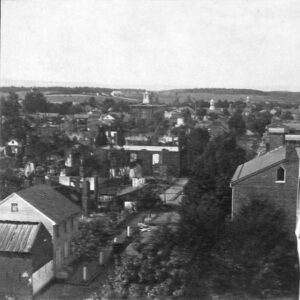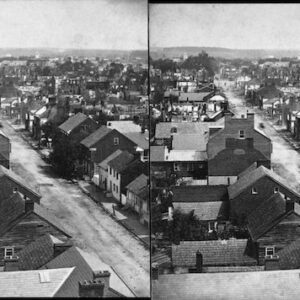Tag: Chambersburg PA
Wikipedia says: Chambersburg is a borough in and the county seat of Franklin County, in the South Central region of Pennsylvania, United States. It is in the Cumberland Valley, which is part of the Great Appalachian Valley, and 13 miles (21 km) north of Maryland and the Mason-Dixon line and 52 miles (84 km) southwest of Harrisburg, the state capital.
Chambersburg’s settlement began in 1730 when water mills were built at Conococheague Creek and Falling Spring Creek. The town developed on both sides of these creeks. Its history includes episodes relating to the French and Indian War, the Whiskey Rebellion, John Brown’s raid on Harpers Ferry, and the American Civil War. The borough was the only major northern community burned down by Confederate forces during the war. Residents charged the Confederates with war crimes.
Civil War era
Underground Railroad / John Brown
By 1859, Chambersburg and its active community of free and enslaved blacks and sympathetic whites was a stop on the Underground Railroad. Several schools taught black children, although such activity was illegal in Virginia and other slave states further south. John Brown stayed in an upstairs room at Mary Ritner’s boarding house between June and October, 1859 while preparing for his raid on Harpers Ferry (then in Virginia). Several of his fellow raiders stayed in the house as well, and four of them escaped capture and briefly visited the house after the raid. The house still stands at 225 East King Street. While in Chambersburg, Brown posed as Dr. Isaac Smith, an iron mine developer, and bought, shipped, and stored weapons under the guise of mining equipment.
Brown (using the name John Smith) and John Henry Kagi met with Frederick Douglass and Shields Green at an abandoned quarry outside of town to discuss the raid on August 19. According to Douglass’s account, Brown described the planned raid in detail and Douglass advised him against it. Douglass also provided $10 from a supporter, and had helped Green – a future raider – locate Brown.
First two Confederate occupations, selective burnings
During the American Civil War on October 10, 1862, Confederate Maj. Gen. J.E.B. Stuart, with 1,800 cavalrymen, raided Chambersburg, destroying $250,000 of railroad property and taking 500 guns, hundreds of horses, and at least “eight young colored men and boys.” They failed, however, to accomplish one of the main targets of the raid: to burn the railroad bridge across the Conococheague Creek at Scotland, five miles (8 km) north of town.
During the early days of the 1863 Gettysburg Campaign, a Virginia cavalry brigade under Brig. Gen. Albert G. Jenkins occupied the town and burned several warehouses and Cumberland Valley Railroad structures and the bridge at Scotland. From June 24–28, 1863, much of the Army of Northern Virginia passed through Chambersburg en route to Carlisle and Gettysburg, and General Robert E. Lee established his headquarters at a nearby farm.
July 30, 1864 devastation
The following year, Chambersburg was invaded for a third time, as cavalry, dispatched from the Shenandoah Valley by Jubal Early, arrived. On July 30, 1864, a large portion of the town was burned down by Confederate Brig. Gen. John McCausland for failing to provide a ransom of $500,000 in U.S. currency, or $100,000 in gold. The local bank had sent its reserves out of town for safekeeping. Among the few buildings left standing was the Masonic Temple, which had been guarded under orders by a Confederate member of the Masons. Norland, the home of Republican politician and editor Alexander McClure, was burned although it was well north of the main fire. Early had ordered the ransom as compensation for those residents of the Shenandoah Valley whose homes has been burned by Union Brig.-Gen. David Hunter. He also burned the Virginia Military Institute.
One black Chambersburg resident was killed when Confederates refused to allow him to leave his burning house. Another man was asked by the Confederates if he had ever educated “niggers”; after replying that he had, the Confederates burned his house as well. Subsequently, “Remember Chambersburg” soon became a Union battle cry.
Accusations of war crimes
Confederate Lieutenant General Jubal Early was accused of war crimes for ordering Chambersburg burned. The actual burning divided two of his cavalry commanders, because when Maryland-born Gen. Joseph “Allegheny” Johnson saw the behavior of Gen. McCausland’s troops in Chambersburg, he refused to participate in a similar burning at Cumberland and Hancock, Maryland not far to the south, so both those towns survived despite likewise not paying ransoms. Union cavalry under Brig. Gen. William W. Averell, although initially misdirected toward Baltimore and thus late to arrive to prevent the atrocities, also pursued the Confederates, who sustained several defeats and lost most of the Shenandoah Valley by November. Furthermore, when the Army of Northern Virginia surrendered on April 9, 1865, Early escaped to Texas by horseback, where he hoped to find a Confederate force still holding out. He proceeded to Mexico, and from there, sailed to Cuba and Canada. Living in Toronto, he wrote his memoir, A Memoir of the Last Year of the War for Independence, in the Confederate States of America, which focused on his Valley Campaign and was published in 1867.
Showing all 15 resultsSorted by latest
-

Image ID: AYYJ
$0.99 -

Image ID: AYYL
$0.99 -

Image ID: APWQ
$4.99 -

Image ID: APWR
$4.99 -

Image ID: APWS
$4.99 -

Image ID: APWT
$4.99 -

Image ID: APWU
$4.99 -

Image ID: APXE
$5.99 -

Image ID: APXF
$5.99 -

Image ID: APXH
$4.99 -

Image ID: APXI
$4.99 -

Image ID: APXJ
$4.99 -

Image ID: ASBA
$5.99 -

Image ID: ASBB
$5.99 -

Image ID: AXBL
$4.99